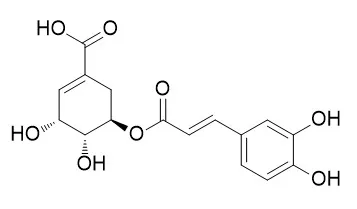| In vitro: |
| In Vivo. 2009 Jul-Aug;23(4):545-50. | | Screening of some saponins and phenolic components of Tribulus terrestris and Smilax excelsa as MDR modulators.[Pubmed: 19567388] | | Cytotoxic activity of saponins and phenolic compounds have been described in the literature, but no reports were found on their multidrug resistance (MDR)-modulating effects on human mdr1 gene-transfected mouse lymphoma cell line.
MATERIALS AND METHODS:
Methylprototribestin, structurally related compounds and a mixture of 3 acetylated isomers of methylprotodioscin were investigated for antiproliferative effect and modulation of drug accumulation.
RESULTS:
The growth inhibitory dose (ID50) of the compounds ranged from 12.64 to 20.62 mug/ml. Methylprototribestin was the most effective resistance modifier. However, methylprotodioscin, pseudoprotodioscin, prosapogenin A of dioscin, tribestin and 5-O-Caffeoylshikimic acid showed moderate MDR reversal activity. In a checkerboard method, methyloprototribestin and the mixture of the 3 acetylated isomers enhanced the antiproliferative effects on MDR cells in combination with doxorubicin.
CONCLUSION:
Based on these results, methylprototribestin and the mixture of the 3 acetylated isomers can be recommended for further in vivo experiments in combination with anthracyclines in human MDR-cancer xenograft transplanted mice. | | Evid Based Complement Alternat Med. 2014;2014:910438. | | Antioxidant and Anti-Inflammatory Activities of Phenolic-Enriched Extracts of Smilax glabra.[Pubmed: 25477999 ] | Smilax glabra Roxb. has been used for a long time as both food and folk medicine. In the present study, phenolic-enriched extract of S. glabra (PEESG) was extracted with 70% ethanol and purified by HP-20 column chromatography.
METHODS AND RESULTS:
Its antioxidant and anti-inflammatory activities were evaluated by radical scavenging assay, reducing power determination, and lipopolysaccharide (LPS)-induced RAW264.7 cells assays, respectively. PEESG exhibited obviously scavenging capacity for DPPH and ABTS radicals, as well as significant reducing power for ferric ion. Particularly, PEESG (12.5-50 μg/mL) showed a significantly higher efficiency for scavenging ABTS than that of ascorbic acid and no significant difference with ascorbic acid for DPPH scavenging. PEESG also possessed a significant suppression effect on proinflammatory mediators production, such as nitric oxide (NO), tumor necrosis factor-α (TNF-α), and interleukin-6 (IL-6), in LPS-induced RAW264.7 cells. In addition, the main ingredients of PEESG were identified using ultrahigh pressure liquid chromatography coupled to electrospray mass spectrometry (U-HPLC-ESI-MS).
CONCLUSIONS:
Seventeen components, including 5-O-Caffeoylshikimic acid, neoastilbin, astilbin, neoisoastilbin, isoastilbin, engetin and isoengeletin were identified. These findings strongly suggest the potential of PEESG as a natural antioxidant and anti-inflammatory agent. |
|






 Cell. 2018 Jan 11;172(1-2):249-261.e12. doi: 10.1016/j.cell.2017.12.019.IF=36.216(2019)
Cell. 2018 Jan 11;172(1-2):249-261.e12. doi: 10.1016/j.cell.2017.12.019.IF=36.216(2019) Cell Metab. 2020 Mar 3;31(3):534-548.e5. doi: 10.1016/j.cmet.2020.01.002.IF=22.415(2019)
Cell Metab. 2020 Mar 3;31(3):534-548.e5. doi: 10.1016/j.cmet.2020.01.002.IF=22.415(2019) Mol Cell. 2017 Nov 16;68(4):673-685.e6. doi: 10.1016/j.molcel.2017.10.022.IF=14.548(2019)
Mol Cell. 2017 Nov 16;68(4):673-685.e6. doi: 10.1016/j.molcel.2017.10.022.IF=14.548(2019)